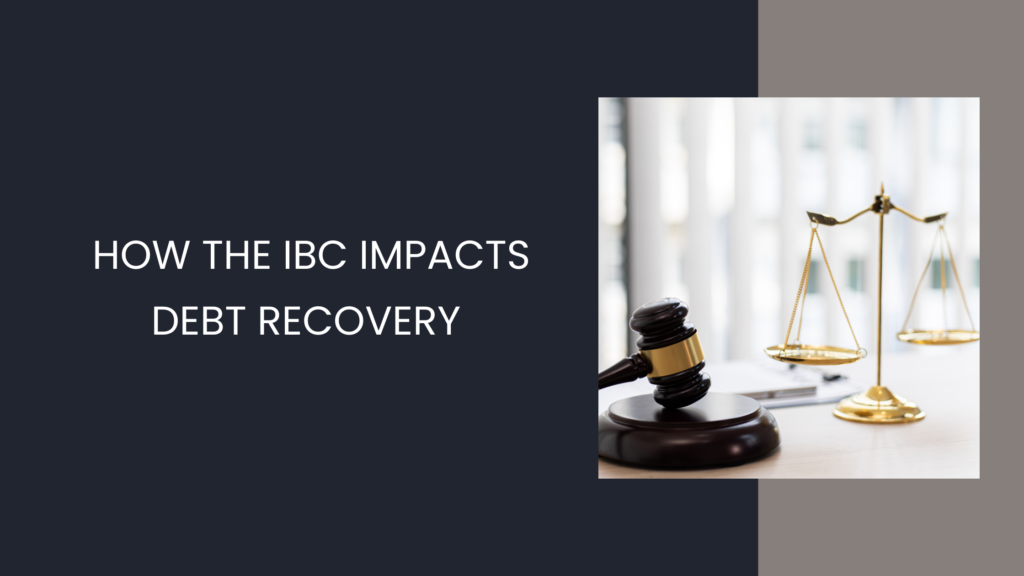In the ever-evolving landscape of financial and legal regulations in India, the Insolvency and Bankruptcy Code (IBC) stands out as a pivotal piece of legislation. Enacted in 2016, the IBC revolutionized the way debt recovery is approached, providing a structured and efficient mechanism for resolving insolvency and bankruptcy issues. For creditors, debtors, and legal professionals, understanding how the IBC impacts debt recovery is essential for navigating the complexities of financial distress and ensuring effective resolution. In this blog, we’ll explore the key ways the IBC influences debt recovery in India and its significance for various stakeholders.
What Is the Insolvency and Bankruptcy Code (IBC)?
The Insolvency and Bankruptcy Code (IBC) is a comprehensive legal framework designed to address insolvency and bankruptcy issues for both individuals and corporate entities. Its primary objectives are to promote entrepreneurship, improve credit availability, and ensure timely resolution of insolvency cases. The IBC provides a uniform process for insolvency resolution and bankruptcy proceedings, aiming to balance the interests of creditors and debtors.
Key Impacts of the IBC on Debt Recovery
1. Streamlined Insolvency Resolution Process
The IBC introduces a streamlined process for insolvency resolution, which significantly impacts debt recovery by:
Timely Resolution: The IBC mandates a time-bound resolution process, with corporate insolvency resolution proceedings (CIRP) required to be completed within 180 days, extendable by another 90 days. This ensures that insolvency cases are resolved promptly, minimizing delays in debt recovery.
Professional Management: During the CIRP, an insolvency professional (IP) is appointed to manage the affairs of the insolvent entity. This professional management helps in maintaining the value of the distressed assets, enhancing the prospects of recovery for creditors.
2. Introduction of the Resolution Framework
The IBC introduces a structured resolution framework that impacts debt recovery in the following ways:
Resolution Plan: Creditors are invited to submit resolution plans for the insolvent entity. The resolution plan aims to revive the distressed company while addressing the interests of creditors. Approved plans facilitate recovery of debts through asset restructuring, operational improvements, or other strategic measures.
Committee of Creditors (CoC): The CoC, comprising financial creditors, plays a crucial role in approving resolution plans. The CoC’s decisions are binding, ensuring that creditors have a say in the resolution process and can influence the outcome to optimize their recovery.
3. Priority of Claims and Recovery
The IBC establishes a clear hierarchy of claims and priorities, impacting how debts are recovered:
Waterfall Mechanism: The IBC outlines a priority order for the distribution of proceeds from the liquidation of assets. Secured creditors are paid first, followed by unsecured creditors, operational creditors, and equity holders. This hierarchy ensures a systematic approach to debt recovery.
Operational Creditors: The IBC provides operational creditors (such as suppliers and service providers) with enhanced rights to claim their dues. This inclusion helps in improving recovery prospects for these creditors.
4. Avoidance of Insolvency
The IBC promotes preventive measures to avoid insolvency, which impacts debt recovery positively:
Pre-Packaged Insolvency Resolution: The IBC allows for pre-packaged insolvency resolution processes (PPIRP) for micro, small, and medium enterprises (MSMEs). This alternative resolution mechanism helps in addressing financial distress early, avoiding prolonged insolvency and improving recovery outcomes.
Early Warning Systems: The IBC encourages early detection of financial distress through regular reporting and compliance requirements, enabling timely intervention and improving the chances of successful debt recovery.
5. Impact on Debt Recovery Enforcement
The IBC also affects the enforcement of debt recovery in several ways:
Moratorium: Upon the initiation of insolvency proceedings, a moratorium is imposed, which prevents creditors from initiating or continuing any legal action against the insolvent entity. This temporary relief allows for a focus on resolution rather than enforcement actions.
Judicial Review: The IBC provides a framework for judicial review of resolution plans and insolvency proceedings. This oversight ensures transparency and fairness in the resolution process, contributing to a more equitable recovery for creditors.
Challenges and Considerations
While the IBC has significantly improved the debt recovery landscape, there are challenges and considerations:
Complexity and Compliance: The IBC’s procedures can be complex, and adherence to timelines and legal requirements is crucial. Creditors and debtors must navigate these complexities effectively to achieve favorable outcomes.
Impact on Small Creditors: While the IBC provides mechanisms for operational creditors, smaller creditors may still face challenges in recovering their dues, especially if they are not well-represented in the CoC.
Conclusion
The Insolvency and Bankruptcy Code (IBC) has had a profound impact on debt recovery in India, providing a structured, time-bound, and transparent framework for resolving insolvency and bankruptcy issues. By streamlining the resolution process, introducing a clear priority of claims, and promoting early intervention, the IBC enhances the efficiency and effectiveness of debt recovery. For stakeholders involved in debt recovery, understanding the nuances of the IBC is essential for navigating the complexities of financial distress and achieving optimal recovery outcomes


